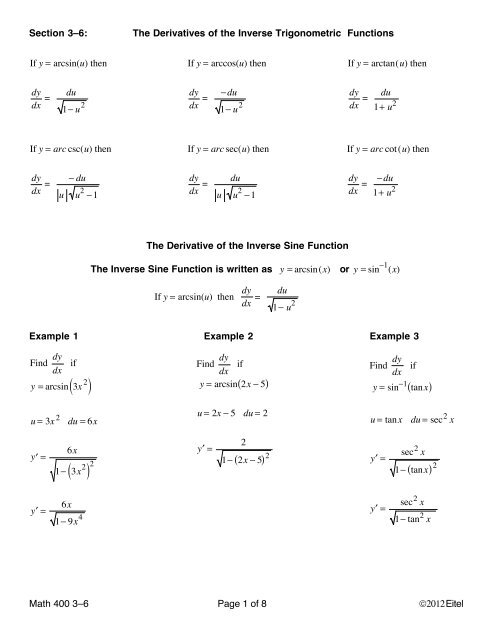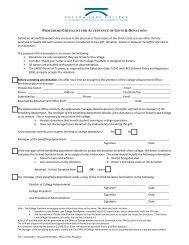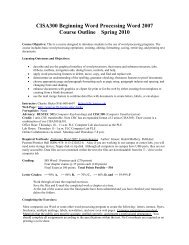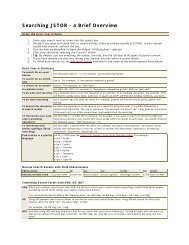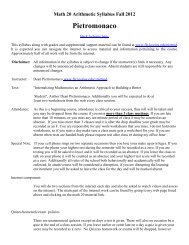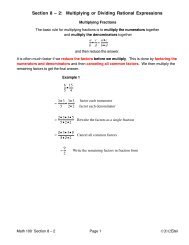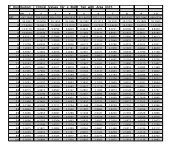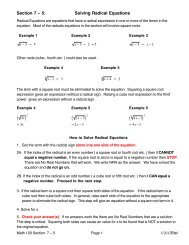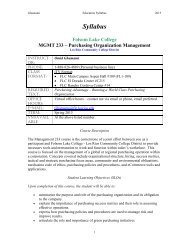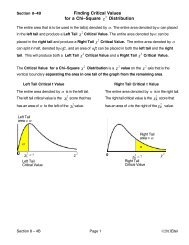Derivatives of the Inverse Trigonometric Functions
Derivatives of the Inverse Trigonometric Functions
Derivatives of the Inverse Trigonometric Functions
You also want an ePaper? Increase the reach of your titles
YUMPU automatically turns print PDFs into web optimized ePapers that Google loves.
Section 3–6:<br />
The <strong>Derivatives</strong> <strong>of</strong> <strong>the</strong> <strong>Inverse</strong> <strong>Trigonometric</strong> <strong>Functions</strong><br />
If y = arcsin(u) <strong>the</strong>n<br />
If y = arccos(u) <strong>the</strong>n<br />
If y = arctan(u) <strong>the</strong>n<br />
dy<br />
dx =<br />
du<br />
1− u 2<br />
dy<br />
dx =<br />
−du<br />
1− u 2<br />
dy<br />
dx =<br />
du<br />
1 + u 2<br />
If y = arc csc(u) <strong>the</strong>n<br />
If y = arc sec(u) <strong>the</strong>n<br />
If y = arc cot(u) <strong>the</strong>n<br />
dy<br />
dx =<br />
u<br />
− du<br />
u 2 −1<br />
dy<br />
dx =<br />
u<br />
du<br />
u 2 −1<br />
dy<br />
dx = −du<br />
1 + u 2<br />
The Derivative <strong>of</strong> <strong>the</strong> <strong>Inverse</strong> Sine Function<br />
The <strong>Inverse</strong> Sine Function is written as y = arcsin(x) or y = sin −1 (x)<br />
If y = arcsin(u) <strong>the</strong>n<br />
dy<br />
dx =<br />
du<br />
1− u 2<br />
Example 1 Example 2 Example 3<br />
Find dy<br />
dx<br />
if<br />
( )<br />
y = arcsin 3x 2<br />
u = 3x 2<br />
y ′ =<br />
du = 6x<br />
6x<br />
( ) 2<br />
1− 3x 2<br />
Find dy if<br />
dx<br />
y = arcsin 2x − 5<br />
u = 2x − 5 du = 2<br />
y ′ =<br />
Find dy<br />
dx<br />
( )<br />
2<br />
( ) 2 y ′ =<br />
1− 2x − 5<br />
if<br />
( )<br />
y = sin −1 tanx<br />
u = tanx du = sec 2 x<br />
sec 2 x<br />
1− ( tanx) 2<br />
y ′ =<br />
6x<br />
1− 9x 4<br />
y ′ =<br />
sec 2 x<br />
1− tan 2 x<br />
Math 400 3–6 Page 1 <strong>of</strong> 8 ©2012 Eitel
The Derivative <strong>of</strong> <strong>the</strong> <strong>Inverse</strong> Cosine Function<br />
The <strong>Inverse</strong> Cosine Function is written as<br />
y = arccos(x) or y = cos −1 (x)<br />
If y = arccos(u) <strong>the</strong>n<br />
dy<br />
dx =<br />
−du<br />
1− u 2<br />
Example 1 Example 2 Example 3<br />
Find dy<br />
dx<br />
if<br />
( )<br />
y = arccos 4x 2<br />
Find dy<br />
dx<br />
if<br />
( )<br />
y = arccos e x<br />
Find dy if<br />
dx<br />
y = arccos sin x<br />
( )<br />
u = 4x 2<br />
du = 8x<br />
u = e x<br />
du = e x<br />
u = sinx du = cos x<br />
y ′ =<br />
y ′ =<br />
−8x<br />
( ) 2<br />
1− 4 x 2<br />
−8x<br />
1−16x 4<br />
y ′ =<br />
y ′ =<br />
−e x<br />
( ) 2<br />
1− e x<br />
−e x<br />
1− e 2x<br />
y ′ =<br />
y ′ =<br />
−cos x<br />
1− sin 2 x<br />
−cos x<br />
cos 2 x<br />
y ′ =<br />
−cosx<br />
cosx<br />
Math 400 3–6 Page 2 <strong>of</strong> 8 ©2012 Eitel
The Derivative <strong>of</strong> <strong>the</strong> <strong>Inverse</strong> Tangent Function<br />
The <strong>Inverse</strong> Tangent Function is written as y = arctan(x) or y = tan −1 (x)<br />
If y = arctan(u) <strong>the</strong>n<br />
dy<br />
dx =<br />
du<br />
1 + u 2<br />
Example 1 Example 2 Example 3<br />
Find dy<br />
Find dy if<br />
if<br />
dx<br />
dx<br />
y = arctan( x )<br />
y = arctan( 3x 2 )<br />
u = x du = 1<br />
2 x<br />
u = 3x 2 du = 6x<br />
1<br />
6x<br />
y ′ =<br />
1 + ( 3x 2 ) 2<br />
y ′ =<br />
2 x<br />
1 + ( x ) 2<br />
6x<br />
1<br />
y ′ =<br />
1 + 9x 4 y ′ =<br />
2 x<br />
1 + x<br />
Find dy<br />
dx<br />
if<br />
( )<br />
y = tan −1 sin x<br />
u = sinx du = cos x<br />
y ′ =<br />
cosx<br />
1 + sin 2 x<br />
y ′ =<br />
1<br />
2 x 1 + x ( )<br />
Math 400 3–6 Page 3 <strong>of</strong> 8 ©2012 Eitel
The relationship between <strong>the</strong> The relationship between <strong>the</strong> The relationship between <strong>the</strong><br />
arcsec and arc cos functions arccsc and arcsin functions arctan and arccot functions<br />
⎛ 1⎞<br />
arcsec (x) = arccos<br />
⎝ x⎠<br />
⎛ 1⎞<br />
arccsc (x) = arcsin<br />
⎝ x⎠<br />
⎛ 1⎞<br />
arccot (x) = arctan if x > 0<br />
⎝ x⎠<br />
⎛ 1⎞<br />
arccot (x) = π + arctan if x < 0<br />
⎝ x⎠<br />
If you wanted to find <strong>the</strong> derivative <strong>of</strong> an arcsec function, you could convert it to an arccos function using <strong>the</strong><br />
rules listed above and <strong>the</strong>n take <strong>the</strong> derivative <strong>of</strong> <strong>the</strong> arccos function. This same technique could be used<br />
to find <strong>the</strong> derivatives for arccsc and arccot functions. In most cases we do not do this. We use <strong>the</strong><br />
derivative rules listed below and take <strong>the</strong> derivatives directly.<br />
If y = arc sec(u) <strong>the</strong>n<br />
If y = arc csc(u) <strong>the</strong>n<br />
If y = arctan(u) <strong>the</strong>n<br />
dy<br />
dx =<br />
u<br />
du<br />
u 2 −1<br />
dy<br />
dx =<br />
u<br />
− du<br />
u 2 −1<br />
dy<br />
dx = −du<br />
1 + u 2<br />
The Derivative <strong>of</strong> <strong>the</strong> <strong>Inverse</strong> Secant Function y = arcsec (x) or y = arcsec −1 (x)<br />
If y = arc sec(u) <strong>the</strong>n<br />
dy<br />
dx =<br />
u<br />
du<br />
u 2 −1<br />
Example 1 Example 2<br />
Find dy<br />
dx<br />
if<br />
( )<br />
y = arcsec 3x 2<br />
Find dy<br />
dx<br />
if<br />
( )<br />
y = arcsec e x<br />
u = 3x 2<br />
du = 6x<br />
u = e x<br />
du = e x<br />
y ′ =<br />
6x<br />
3x 2 3x 2<br />
( ) 2 −1<br />
y ′ =<br />
e x<br />
e x<br />
( e x ) 2 −1<br />
y ′ =<br />
3x 2<br />
6x<br />
9x 4 −1<br />
y ′ =<br />
e x<br />
e x<br />
( e x ) 2 −1<br />
y ′ =<br />
x<br />
2<br />
9x 4 −1<br />
y ′ =<br />
1<br />
e 2x −1<br />
Math 400 3–6 Page 4 <strong>of</strong> 8 ©2012 Eitel
The Derivative <strong>of</strong> <strong>the</strong> <strong>Inverse</strong> Cosecant Function y = arccsc (x) or y = arccsc −1 (x)<br />
If y = arc csc(u) <strong>the</strong>n<br />
dy<br />
dx =<br />
u<br />
− du<br />
u 2 −1<br />
Example 1 Example 2<br />
Find dy<br />
dx<br />
if<br />
( )<br />
y = arccsc x 2 − 2<br />
Find dy<br />
dx<br />
if<br />
( )<br />
y = arccsc 2x 3<br />
u =<br />
x 2 − 2 du = 2x<br />
u = 2x 3 du = 6x 2<br />
y ′ =<br />
−2x<br />
x 2 − 2 ( x 2 − 2) 2 −1<br />
y ′ =<br />
−6x 2<br />
2x 3 2x 3<br />
( ) 2 −1<br />
y ′ =<br />
2x 3<br />
−6x 2<br />
4x 6 −1<br />
y ′ =<br />
2x 2 x<br />
−6x 2<br />
4 x 6 −1<br />
y ′ =<br />
x<br />
−3<br />
4x 6 −1<br />
Math 400 3–6 Page 5 <strong>of</strong> 8 ©2012 Eitel
<strong>Derivatives</strong> with <strong>Inverse</strong> <strong>Trigonometric</strong> <strong>Functions</strong> and Polynomial functions<br />
Example 1<br />
Quotient Rule<br />
Find dy<br />
dx<br />
if y = arcsin ( x)<br />
x<br />
der<br />
bottom 67 8 64 7<br />
<strong>of</strong><br />
48<br />
top<br />
1<br />
y ′ = x •<br />
1− x 2<br />
top der<br />
64 748<br />
6 <strong>of</strong> 7 bottom 8<br />
− arcsin x • 1<br />
( )<br />
y ′ = x •<br />
1<br />
1− x 2<br />
− arcsin ( x)<br />
•1<br />
y ′ =<br />
x<br />
( )<br />
1− x 2 − arcsin x<br />
Example 2<br />
Product Rule<br />
Find dy<br />
dx<br />
if y = x 2 arctan( x)<br />
first der<br />
67 8 64 7 <strong>of</strong> 4 sec 8<br />
y ′ = x 1 1<br />
•<br />
1− x 2<br />
64 second 748<br />
6 der 47<br />
<strong>of</strong> first 48<br />
+ arcsin x • 2x<br />
( )<br />
y ′ =<br />
x 2 1<br />
•<br />
1 + x 2 + arctan x<br />
= x 2<br />
+ 2x arctan ( x )<br />
1 + x<br />
2<br />
( ) •2x<br />
Math 400 3–6 Page 6 <strong>of</strong> 8 ©2012 Eitel
Example 3<br />
Power Rule<br />
Find dy<br />
dx<br />
if y =<br />
( arctan( x)<br />
) 2<br />
n} 64748<br />
y ′ = 2 • arctan x<br />
u n−1<br />
( ( )) 1<br />
67 du8<br />
1<br />
•<br />
1 + x 2<br />
( ( ) 1 •<br />
y ′ = 2 • arctan x<br />
y ′ =<br />
2arctan( x)<br />
1 + x 2<br />
1<br />
1 + x 2<br />
Example 4<br />
Find dy<br />
dx<br />
if y = arcsin ( x) + arccos ( x)<br />
y ′ =<br />
1<br />
1− x 2 +<br />
−1<br />
1− x 2<br />
y ′ = 0<br />
Math 400 3–6 Page 7 <strong>of</strong> 8 ©2012 Eitel
Find dy<br />
dx<br />
Example 5<br />
if y = arcsin ( x) + x • 1− x 2<br />
( ) 1/2<br />
y = arcsin( x) + x • 1− x 2<br />
dy<br />
dx =<br />
d dx arcsin ( x)<br />
+ d<br />
dx<br />
( ) 1/2<br />
⎛<br />
⎜ x • 1− x 2<br />
⎝<br />
⎞<br />
⎟<br />
⎠<br />
y ′ =<br />
der<br />
6 4<br />
<strong>of</strong><br />
7<br />
arcsin(x)<br />
4 8<br />
1<br />
1− x 2<br />
6 first 78<br />
6<br />
+ x • 1 44 der 7 <strong>of</strong> 4 sec 448<br />
( 1− x2 ) −1/2 •−2x<br />
2<br />
64 second 74<br />
8 der 67 <strong>of</strong> 8 first<br />
• + 1− x 2 • 1<br />
y ′ =<br />
1 ⎡<br />
1− x 2 + x • 1 2 1− x 2<br />
⎣<br />
⎢<br />
( ) −1/2 • −2x<br />
⎤<br />
⎦<br />
⎥ +<br />
1− x2<br />
y ′ =<br />
1<br />
1− x 2 − x 2<br />
1− x 2 + 1− x 2<br />
add <strong>the</strong> first two terms with a common denominator<br />
( )<br />
y ′ = 1− x 2<br />
1− x 2 +<br />
y ′ =<br />
( 1− x2 ) 1<br />
( 1− x 2 )<br />
1− x2<br />
1/2<br />
+ 1− x<br />
2<br />
y ′ = 1− x 2 + 1− x 2<br />
y ′ = 2 1− x 2<br />
Math 400 3–6 Page 8 <strong>of</strong> 8 ©2012 Eitel


